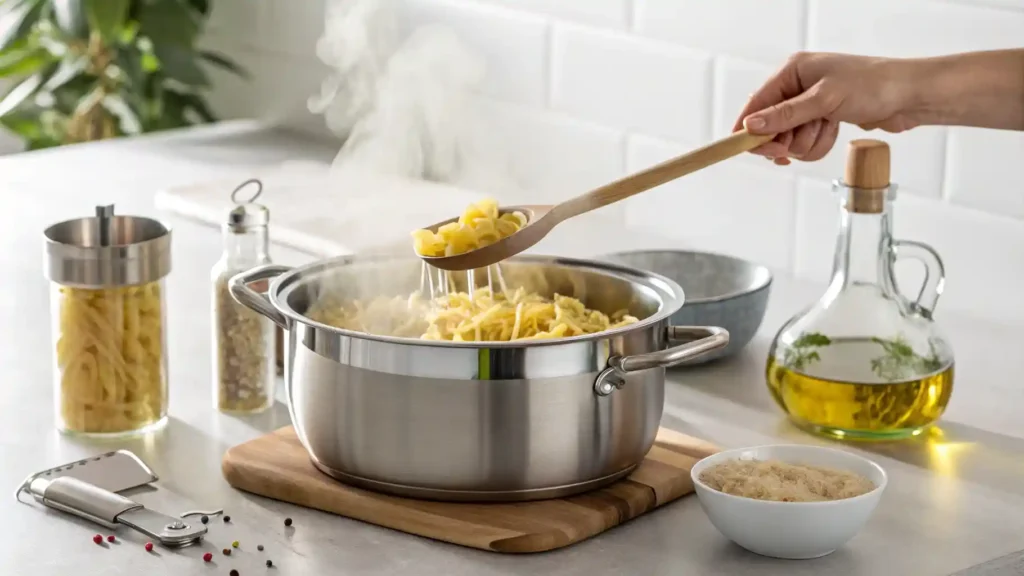Pasta lovers, rejoice! Whether you’re a culinary connoisseur or someone who loves indulging in hearty, comforting dishes, Campanelle pasta deserves a spot in your kitchen. This bell-shaped wonder is not only a feast for the eyes but also a delight to the taste buds. Perfect for soaking up sauces and adding texture to your dishes, Campanelle has become a go-to choice for many chefs and home cooks alike.
In this guide, we’ll explore everything you need to know about Campanelle pasta—from its rich history and unique design to the best ways to cook, serve, and store it. You’ll also discover delicious recipes, comparisons to similar pasta shapes, and answers to frequently asked questions. Let’s dive in!
Table of contents
What Is Campanelle Pasta?
The Origin and History of Campanelle Pasta
Campanelle, which means “little bell” in Italian, hails from the heart of Italian cuisine, where pasta has long been a cornerstone of culinary tradition. This charmingly shaped pasta is believed to have been inspired by the bell flowers native to the Italian countryside. Its design, resembling a small bell or fluted petal, symbolizes elegance and sophistication, reflecting the artistry of Italian food culture.
Historically, Campanelle was crafted by skilled pasta makers who sought to combine form and function. Its ruffled edges and hollow center were not only visually appealing but also incredibly practical for holding thick, flavorful sauces. From rustic kitchens to high-end restaurants, this pasta has become synonymous with versatility and indulgence.
Physical Characteristics of Campanelle Pasta
What sets Campanelle pasta apart from other shapes is its distinct appearance. Imagine a cone-shaped piece of pasta with wavy, petal-like edges—like a tiny trumpet or flower. This unique shape makes it ideal for capturing rich, hearty sauces, whether creamy Alfredo, zesty marinara, or savory Bolognese.
Campanelle is typically made from durum wheat semolina, giving it a firm texture and a slightly nutty flavor. It comes in various sizes, with some brands offering a more tightly curled version, while others showcase a looser, more open design. Whole wheat and gluten-free options are also widely available, catering to diverse dietary needs.
How to Cook Campanelle Pasta
Cooking Campanelle pasta to perfection can elevate your dishes and make every bite a delightful experience. Its unique shape requires just a bit of finesse to bring out its best qualities.

Step-by-Step Cooking Instructions
- Boiling the Water: Fill a large pot with water, approximately 4 quarts per pound of pasta. Add a generous pinch of salt—this step enhances the flavor of the Campanelle pasta.
- Cooking the Pasta: Bring the water to a rolling boil, then add the pasta. Stir occasionally to prevent it from sticking. Cook for 9–11 minutes, or until al dente.
- Draining and Cooling: Drain the pasta but reserve about a cup of the pasta water. This starchy water can help thicken and bind sauces later. Avoid rinsing the pasta unless you’re using it for a cold dish, such as a pasta salad.
Common Mistakes to Avoid While Cooking
- Skipping the Salt: Always salt your water. It’s the only chance to season the pasta itself.
- Overcooking: Campanelle pasta is best when slightly firm, or al dente, as overcooking will cause it to lose its structure and sauce-holding capabilities.
- Not Stirring Enough: Since this pasta has intricate edges, it can stick together if not stirred during cooking.
Nutrition Facts for Cooked Campanelle Pasta
| Nutrient | Amount per 100g |
|---|---|
| Calories | 131 kcal |
| Carbohydrates | 25g |
| Protein | 5g |
| Fat | 1g |
| Fiber | 2g |
| Sodium | 1mg |
Pro Tip: Pair your cooked Campanelle pasta with hearty sauces like marinara, Bolognese, or creamy Alfredo. This pasta shines when used in dishes that allow its unique shape to trap sauce in every bite!
Popular Recipes Featuring Campanelle Pasta

Classic Italian Dishes with Campanelle Pasta
- Campanelle Bolognese: A rich and savory meat sauce clings beautifully to the ruffled edges of the pasta, ensuring each bite is packed with flavor. Start by simmering ground beef and tomatoes, then mix in cooked Campanelle pasta.
- Campanelle Alfredo: Creamy Alfredo sauce, made from butter, heavy cream, and Parmesan, pairs wonderfully with this pasta’s structure. Add grilled chicken or sautéed mushrooms for extra flair.
Creative Modern Twists
- Campanelle Pasta Salad: Perfect for picnics or potlucks, combine cooked Campanelle pasta with cherry tomatoes, mozzarella, olives, and a tangy vinaigrette. The pasta holds onto the dressing and toppings beautifully.
- Vegan Campanelle Primavera: Sauté seasonal vegetables like zucchini, bell peppers, and asparagus in olive oil, then toss with the pasta and fresh herbs. Nutritional yeast adds a cheesy, plant-based touch.
Ingredients for Campanelle Alfredo
| Ingredient | Quantity |
|---|---|
| Campanelle Pasta | 1 pound |
| Butter | 4 tbsp |
| Heavy Cream | 1 cup |
| Parmesan Cheese | 1 cup (grated) |
| Garlic | 2 cloves (minced) |
| Salt & Pepper | To taste |
Pro Tip: When making pasta salad, toss the cooked Campanelle pasta in a bit of olive oil before adding the dressing to keep it from clumping together.
Comparing Campanelle to Other Pasta Shapes
When exploring the world of pasta, the variety of shapes and styles can be overwhelming. But Campanelle pasta stands out with its unique design and versatility. Let’s see how it compares to other popular pasta shapes.
Campanelle vs. Gigli Pasta: Key Differences
At first glance, Campanelle pasta and Gigli might seem almost identical, but there are subtle distinctions:
- Shape and Structure: Campanelle has a bell-like shape with ruffled edges that curve outward, while Gigli tends to look more like a small flower with a tighter curl.
- Texture and Sauce Compatibility: Thanks to its open structure, Campanelle is better at holding chunkier sauces, while Gigli works best with lighter options like pesto or butter-based sauces.
Both pasta shapes, however, are excellent choices when you want a visually appealing dish that highlights texture and flavor.
How Campanelle Stands Out from Other Pasta Shapes
What makes Campanelle pasta a fan favorite is its versatility:
- Sauce-Friendly: Its hollow center and fluted edges are perfect for trapping sauces, whether creamy, meaty, or vegetable-based.
- Eye-Catching Design: The elegant shape adds a decorative touch to any dish, from casual meals to formal presentations.
- Comparison to Other Shapes: While penne or rigatoni might work well with sauces, they lack the intricate texture of Campanelle, which makes every bite uniquely flavorful. Another small pasta shape with a unique texture is Acini de Pepe. This tiny, pearl-like pasta is often used in soups and cold salads, offering a completely different experience compared to Campanelle but equally versatile in creative recipes.
Pro Tip: If you’re looking for pasta similar to Campanelle but with a different bite, consider fusilli or cavatappi. These spiraled shapes also do a great job of clinging to sauces.
For more pasta inspiration, check out this spaghettini pasta recipe for lighter, simpler dishes.
Nutritional Value and Serving Sizes
Understanding the nutritional profile of Campanelle pasta and how much to serve per person can help you create well-balanced meals.
Nutritional Profile of Campanelle Pasta
Like most traditional pasta, Campanelle is made from durum wheat semolina. Here’s a snapshot of its nutritional content per 100g of cooked pasta:
| Nutrient | Amount per 100g |
|---|---|
| Calories | 131 kcal |
| Carbohydrates | 25g |
| Protein | 5g |
| Fat | 1g |
| Fiber | 2g |
| Iron | 10% DV |
For those seeking healthier options, whole wheat or gluten-free Campanelle varieties are available and provide additional fiber and nutrients.
How Much Campanelle Pasta to Serve per Person
When cooking Campanelle pasta, the amount you prepare depends on the type of dish:
- Main Course: Plan for about 100g (or 3.5 ounces) of dried pasta per person. This ensures a satisfying portion, especially when paired with a hearty sauce.
- Side Dish or Salad: Reduce the portion to 60–75g (2–2.5 ounces) of dried pasta per person, allowing room for additional ingredients.
Pro Tip: To avoid food waste, consider the sauce and side dishes when portioning pasta. Creamy sauces like Alfredo can be more filling, while lighter sauces may require slightly larger portions.
If you’re looking for a guide on pairing sauces with different pasta shapes, check out our article on creamy marry-me chicken soup recipes.
FAQs About Campanelle Pasta
Curious about Campanelle pasta? Here, we answer some of the most common questions to help you understand and enjoy this unique pasta shape.
Is Campanelle Pasta Good?
Absolutely! Campanelle pasta is beloved for its versatility, ability to hold sauces, and attractive appearance. Its bell-shaped design, with ruffled edges, makes it perfect for dishes with thick sauces like Bolognese, creamy Alfredo, or chunky vegetable medleys. Additionally, the hollow center ensures that every bite is packed with flavor.
What Is the Difference Between Gigli and Campanelle?
Although similar in design, Gigli and Campanelle are not identical:
- Campanelle: Features a bell-shaped structure with open, flared edges, ideal for capturing sauces.
- Gigli: Tends to have a tighter curl, resembling a flower, and works better with lighter sauces or simple dressings.
Both pasta shapes add flair to your dishes, but Campanelle pasta is better suited for hearty recipes due to its robust structure.
How Would You Describe Campanelle Pasta?
Campanelle pasta is best described as elegant yet functional. Its bell-like shape with wavy edges not only looks stunning on the plate but also serves a practical purpose—it traps sauce and toppings effortlessly. This makes it an excellent choice for creamy or chunky sauces, as well as pasta salads.
How Much Campanelle Pasta per Person?
The serving size of Campanelle pasta depends on the dish:
- For a main course, plan for about 100g (3.5 ounces) of dried pasta per person.
- For a side dish, 60–75g (2–2.5 ounces) is sufficient.
When preparing pasta salads or large casseroles, you can adjust the portion based on the number of ingredients used.
Storing and Buying Campanelle Pasta
Proper storage and sourcing of Campanelle pasta are essential to maintain its quality and taste.
Where to Buy Campanelle Pasta
Campanelle pasta can be found in most grocery stores in the pasta aisle, often sold by well-known brands. For specialty or artisanal options, check out Italian markets or online retailers. Whole wheat, gluten-free, and organic versions are also widely available, offering something for every dietary need.
Best Practices for Storing Dry and Cooked Pasta
- Dry Pasta: Store unopened packages in a cool, dry place, away from direct sunlight. Once opened, transfer the pasta to an airtight container to keep it fresh for up to two years.
- Cooked Pasta: Refrigerate leftovers in an airtight container for up to three days. Tossing the pasta with a bit of olive oil before storing can prevent it from sticking together.
Additional Resources
If you’re inspired by Campanelle pasta, there’s a whole world of pasta recipes waiting to be explored. Don’t forget to check out related dishes for more ideas:
- Creamy Marry-Me Chicken Soup Recipes: Perfect for pairing with Campanelle or as a standalone dish.
- Spaghettini Pasta Recipes: For those who prefer lighter, delicate pasta options.
Cooking is all about creativity, so don’t hesitate to try new combinations and flavors. Ready to get cooking with Campanelle? It’s time to bring the heart of Italy to your kitchen!

